Just as Mexicans celebrate life with colour and fanfare, so do they honour and commemorate death. Mexico’s Día de Muertos (Day of the Dead) is one of the country’s most popular festivals that is now celebrated around the world.
Mexico is filled with fun and fiestas at the best of times. In the weeks leading up to Día de los Muertos, however, the country literally explodes with colour.
Bright orange Mexican Marigolds are everywhere along with colourful Catrinas, sugar skulls iced in blues and pinks and yellows, and intricate papel picado (tissue paper cutouts) hang in shop windows and homes.
At midnight on October 31, Mexico’s most colourful, and most famous, festival officially starts. El Dia de los Muertos (Day of the Dead Festival) is an annual celebration held to honour and remember those who have died. It’s a very vibrant festival, as well as being very moving, a celebration of life that we could all learn something from.
Updated for 2021. This post contains affiliate links. These are not pay-per-click links. For more information, please see our disclosure policy.
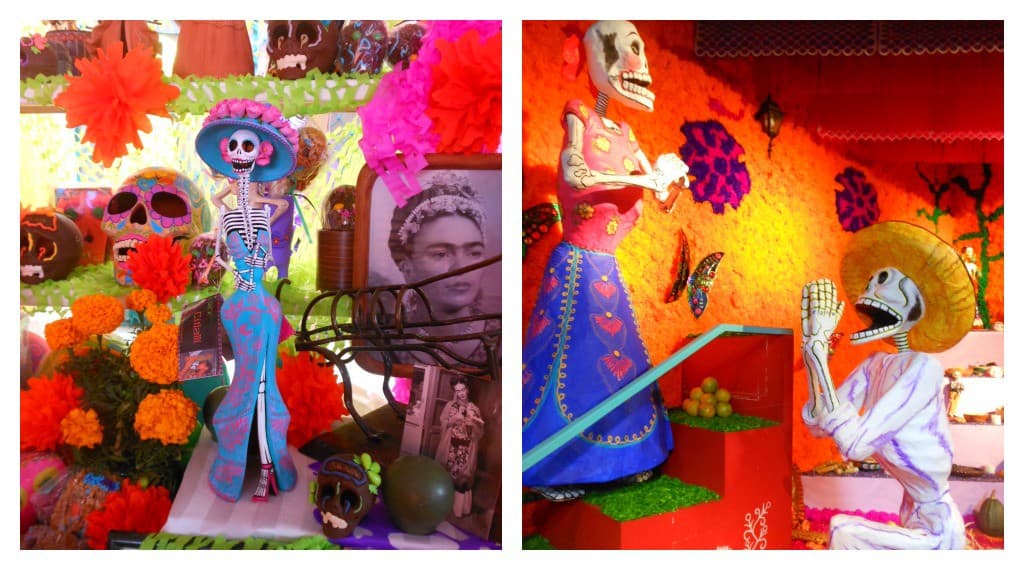
“Follow me, you need to see something special. All the world is made of stories and all of those stories are right here in The Book of Life. But the greatest story begins on the Day of the Dead, a day when spirits pass between worlds and anything can happen.” –
Mary Beth the teacher in The Book of Life
Celebrating the Day of the Dead for kids
Table of Contents
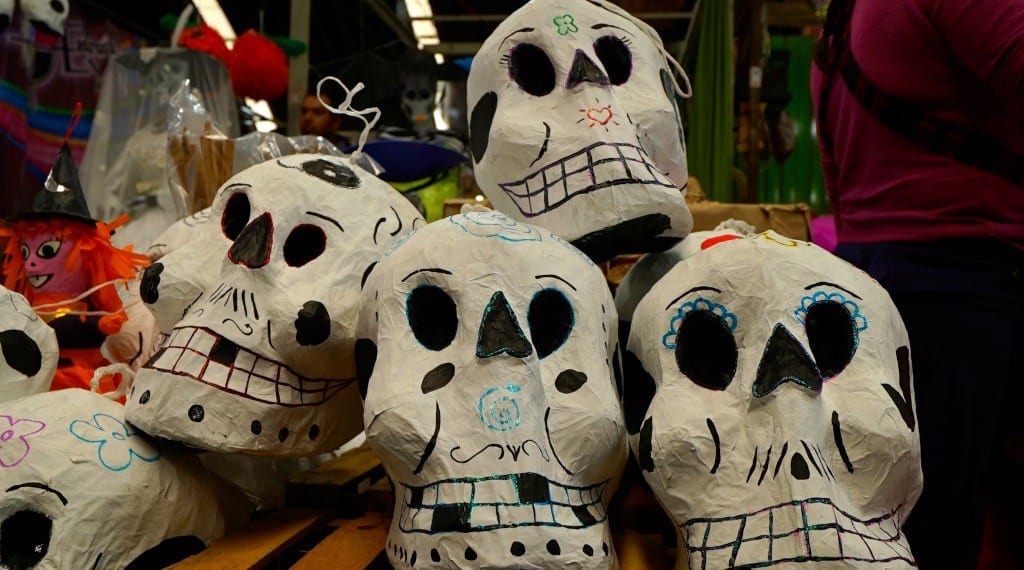
For kids, this is a very fun event as well as an important one. It’s a way for them to learn about death and to understand that it can be something to be celebrated rather than feared. There are lots of ways that you can introduce your children to the Day of the Dead celebration; the end of this post has some of our favourite Day of the Dead activities.
Despite its growing popularity, this is a Mexican holiday with deeply rooted traditions that go back to pre-Hispanic times. During this holiday, the popular belief is that the deceased have permission to visit friends and relatives on earth and once again enjoy that which they did in life.
Despite falling on the dates when Halloween is celebrated, the Day of the Dead festivities are not Halloween celebrations.
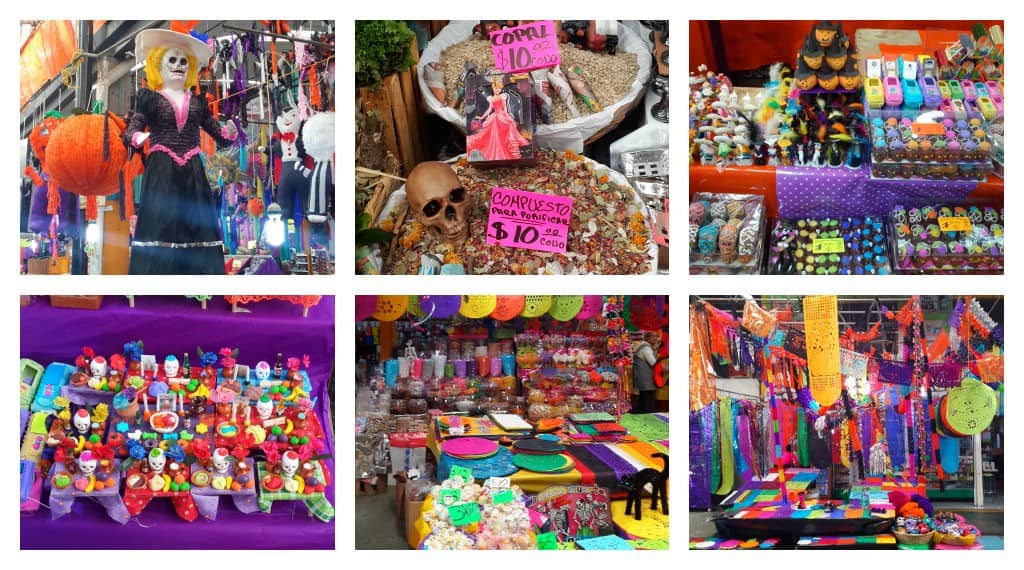
When the Spanish conquistadoras arrived and found people celebrating death they quickly put an end to what they saw as a pagan ritual.
Gradually, however, these traditional beliefs and customs were incorporated into the Catholic calendar. Previously the festival had been celebrated for a month in the summer but it was later moved to the end of October to coincide with the Roman Catholic festival of “Allhallowtide”.
Today the festival coincides with All Saints Day and All Souls’ Day.
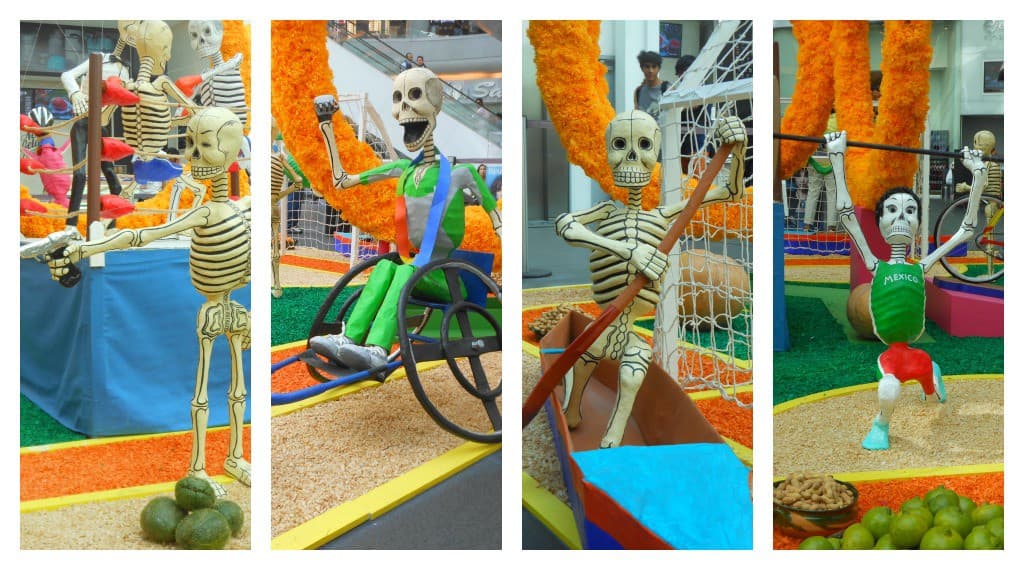
The festival officially starts at midnight on October 31st, although family members are often preparing in the weeks leading up to this, creating ofrendas (altars) in their homes.
In most regions, November 1st is to honour children and infants and November 2nd is to remember deceased adults. Over the course of the holiday, families will visit cemeteries to decorate the graves and tombs of their relatives.
Today Dia de Muertos los Muertos continues to be celebrated throughout Mexico, as well as other parts of Latin America. Each state has their customs – and the traditions remain particularly authentic in the small towns and villages – but the common theme is one of honour and remembrance for those who have died.
Day of the dead traditions
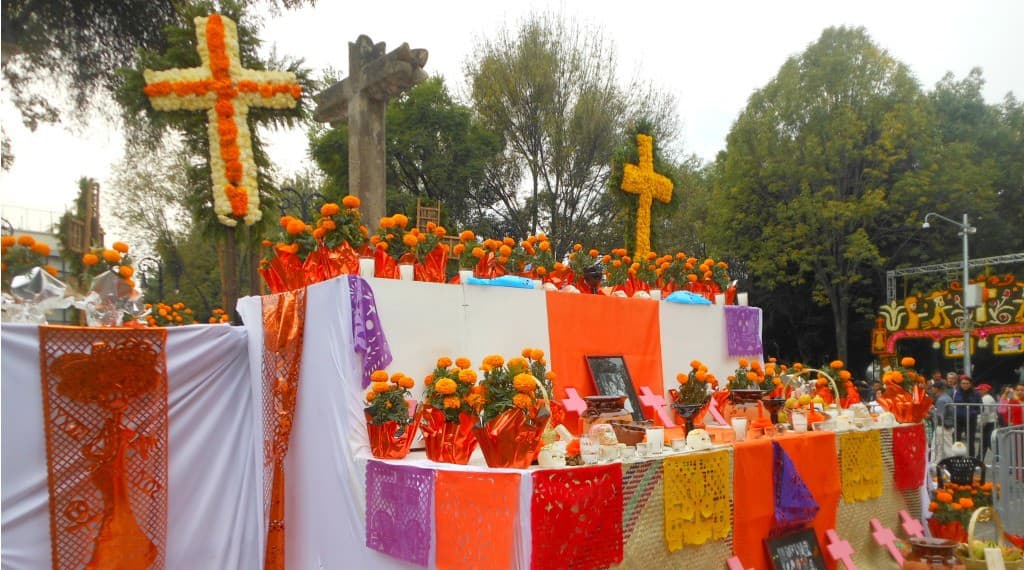
Although customs vary region by region – and in different Latin American countries – there are various traditions and symbols that are commonplace throughout the country.
Ofrenda (altars)
Altars are assembled at home, in cemeteries and outside, in memory of a relative, or relatives, who have died. Traditionally these Dia de los muertos altar are decorated with flowers, photos of the deceased, brightly coloured papel picado (delicate, colourful paper cut outs) and favorite foods, you may even spot a bottle of tequlia or two.
Much like other ancient civilisations, early Mexicans buried their dead with the deceased’s personal possessions as well as things that might help them in their next life. As such, miniature sculptures of favourite foods or small ceramic sculptures of hobbies that the deceased enjoyed in life might also be placed on the ofrenda.
Ofrendas can be elaborate but they can also be a very simple way of remembering someone who has passed.
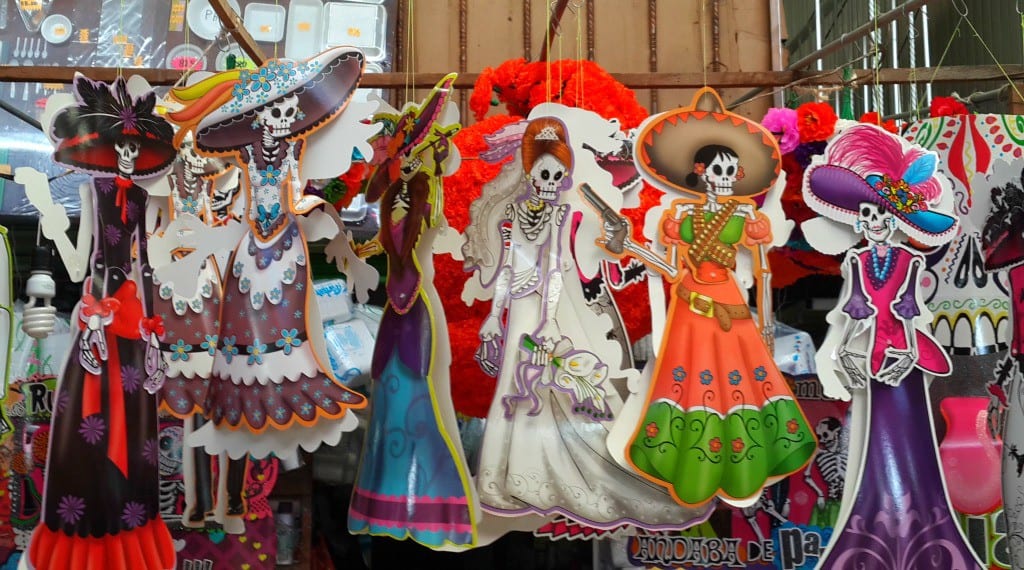
La Catrina
Possibly the most identifiable symbol of Día de Muertos is La Catrina, the elegantly attired female skeleton with her extravagantly plumed hat. She was ‘born’ in the early 1900s as a cartoon designed to poke fun at Mexico’s wealthy classes.
La Catrina was later painted into a mural by Diego Rivera, one of Mexico’s most famous artists. She later became a figure of Mexican culture representing death.
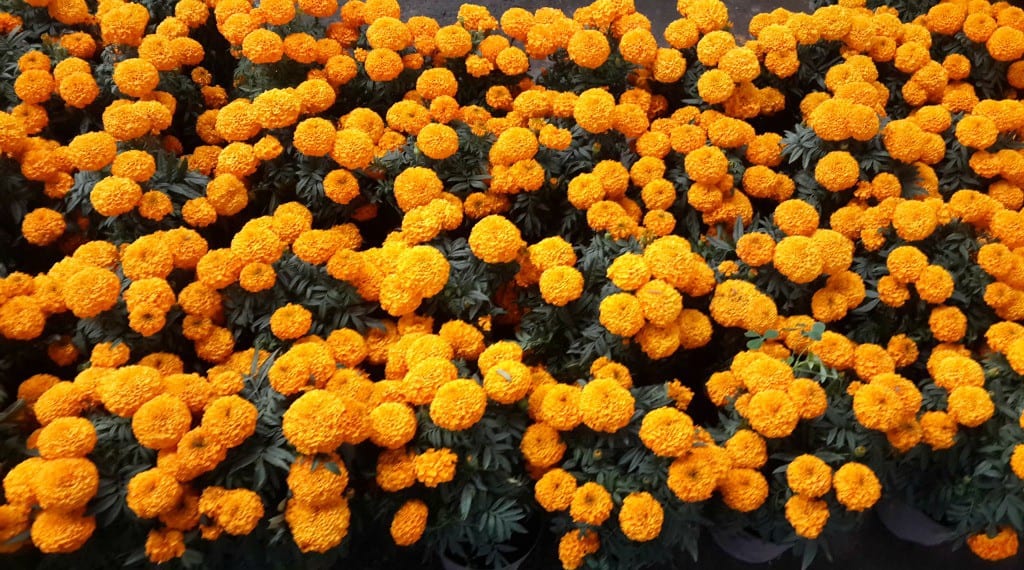
Cempasuchils
Known as flores de muertos or Mexican marigolds, these bright orange flowers can be seen for sale everywhere in the run up to the festival.
Their colour is thought to represent the colour and light of the Sun. Aztecs believed that the Sun would guide dead souls towards the right path. They are used in abundance in churches, cemeteries and homes.
Traditionally, families placed flower petals and candles along the path leading from the cemetery to home. This is so that the departed souls could find their way back to Earth.
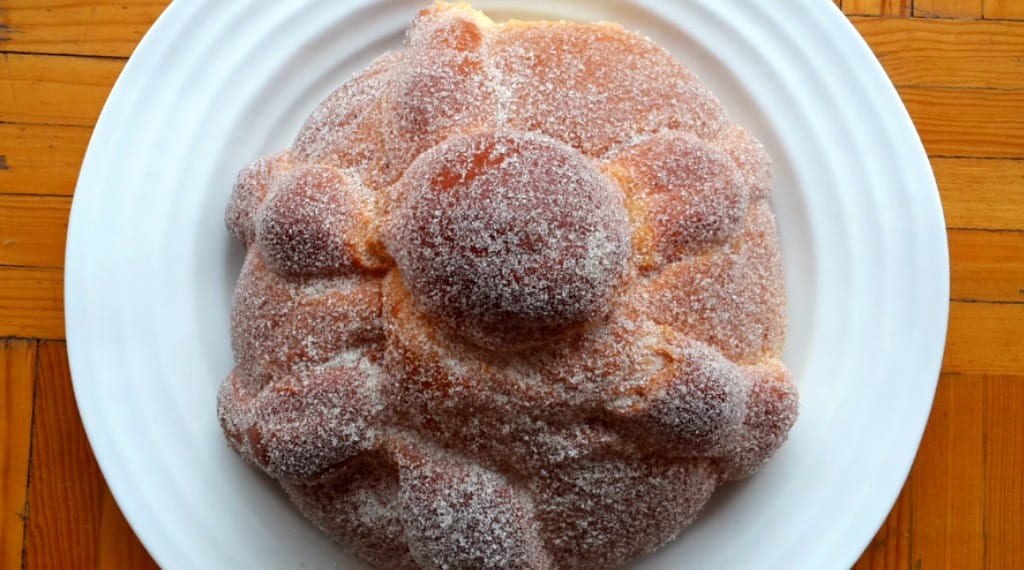
Pan de Muertos
Food plays an important part in the festival and families place the ‘bread of the dead’ – a sweet, round bread decorated with bone-shaped dough and sugar with ‘bones’ – on the altar so that the spirits have something to eat after their long journey home. The bread itself is flavoured with orange and anise.
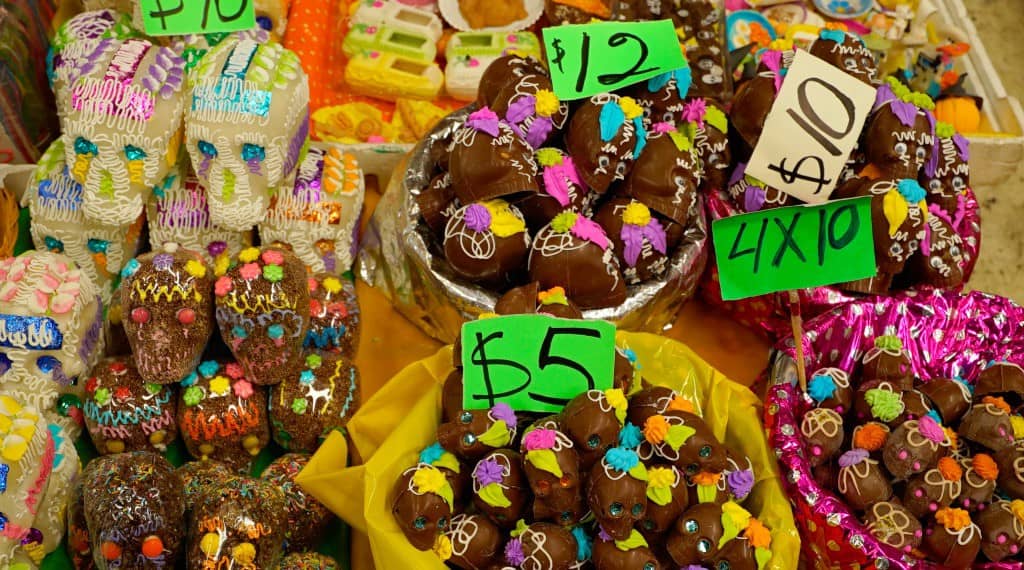
Calaveras
In pre-Hispanic times calaveras (skulls) were often kept as trophies and displayed during rituals to symbolise death and rebirth.
Traditionally, sugar skulls – made by carefully pouring sugar solution into moulds before decorating with coloured icing – are also placed on ofrendas. They can sometimes be eaten but their main purpose is to adorn the altars. Today, chocolate skulls are also popular and these can definitely be eaten!
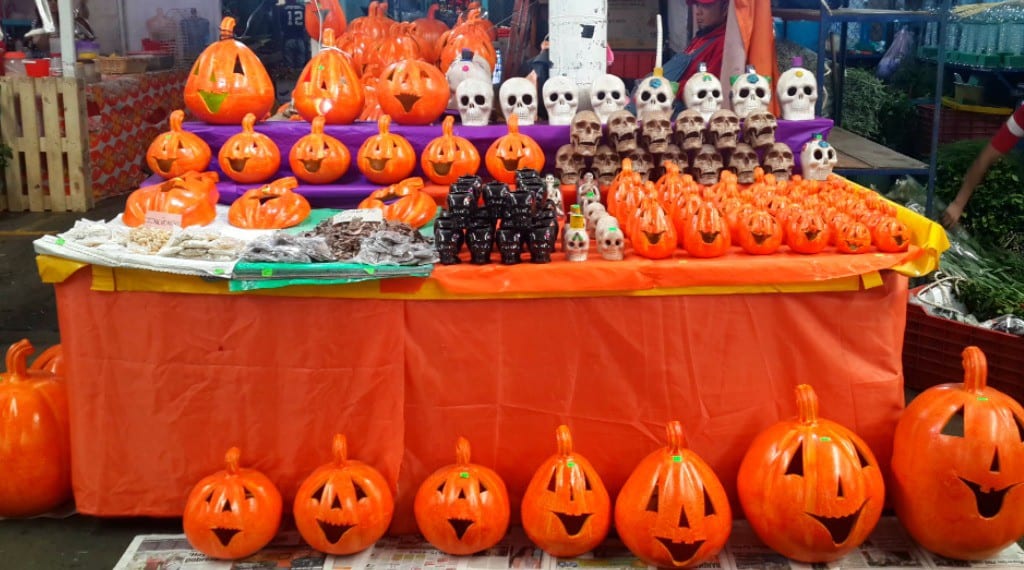
Nowadays, you’ll often see Halloween influences alongside traditional Día de Muertos symbols – a pumpkin here or there or a piñata in the shape of a witch – but this is still a very important holiday for most people in Mexico.
Day of the Dead Activities with kids
There are lots of ways to involve your children in activities to remember those who may have passed.
Watch The Book of Life and Coco
These two excellent animated movies, The Book of Life and Coco, are a wonderful way to learn more about the traditions of Dia de los Muertos.
Released in 2014, The Book of Life tells the tale of two men in love with the same woman. Things get complicated when La Muerte, Queen of the Land of the Remembered and Xibalba, the dark ruler of the Land of the Forgotten, notice the battle between the two suitors and place a bet on who will win. Xibalba doesn’t play fair, however, and consequently sends one of the suitors, Manolo, on a journey into the underworld.
Coco was released in 2017 by Walt Disney Pictures and tells the charming tale of the young boy, Miguel, who dreams of becoming a musician despite his family’s generations-old ban on music. When he finds himself in the Land of the Dead he embarks on a journey to discover the real story behind his family’s history.
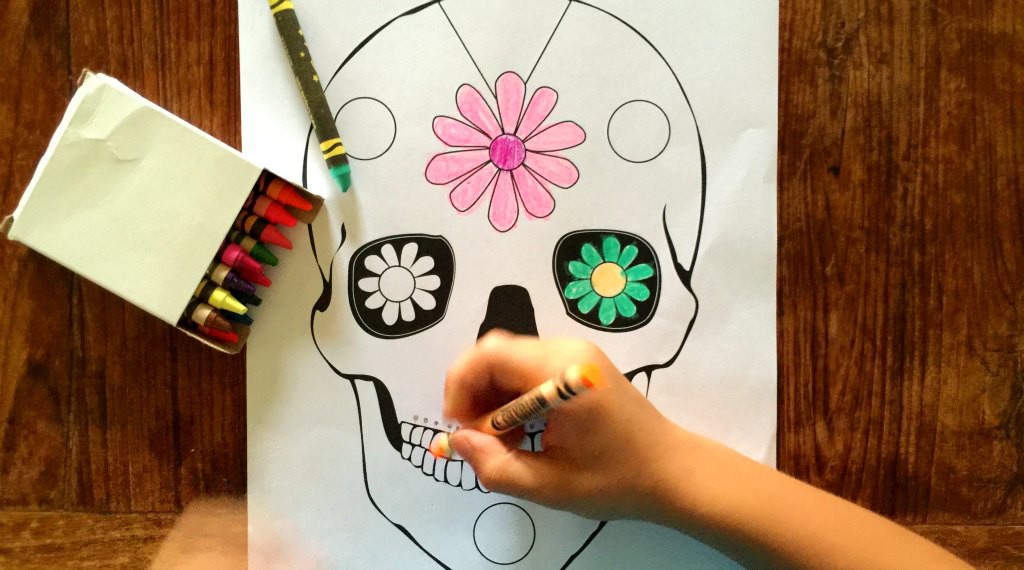
Colour a Calavera
Calaveras (skulls) are one of the most famous symbols of the Day of the Dead. Decorative sugar skulls, topped with coloured icing, can be seen everywhere in the lead up to the holiday. But rather than being scary, these are colourful and happy! Download free printables here.
Bake Pan de Muertos
Food plays an incredibly important part over the festival and one of the most popular foods is pan de muertos, ‘bread of the dead’. This is a sweet bread flavoured with orange and anise that is covered in sugar. ‘Bone’ shapes cross the dough. It’s said that the dead partake of the spirit of the food, while the living enjoy the physical treats at the cemetery.
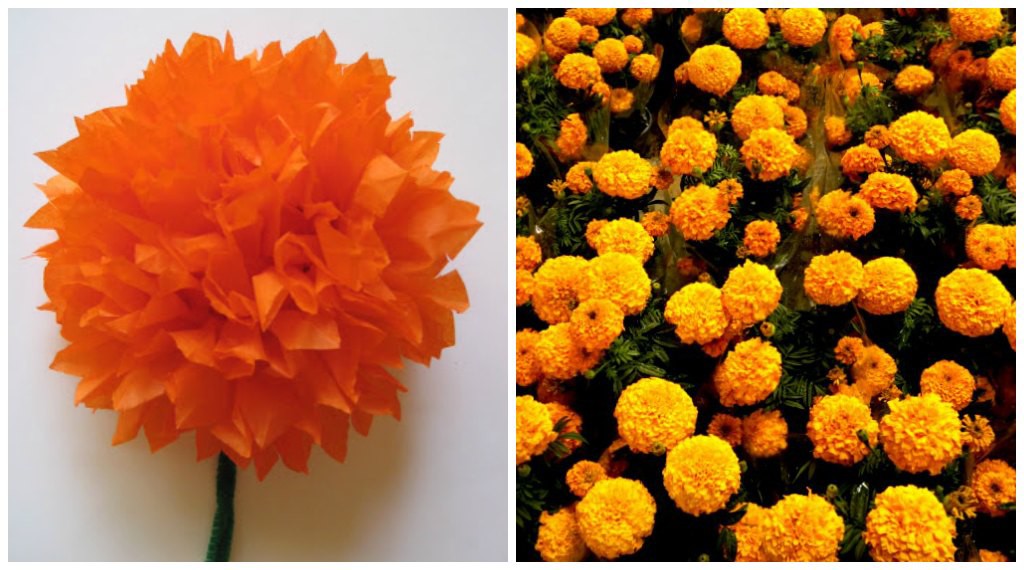
Make Tissue Marigolds
Cempasuchils, otherwise known as flores de muertos or Mexican Marigolds can be seen literally everywhere in Mexico throughout the month of October. Their colour is thought to represent the colour and light of the Sun that Aztecs believed would guide dead souls along the right path.
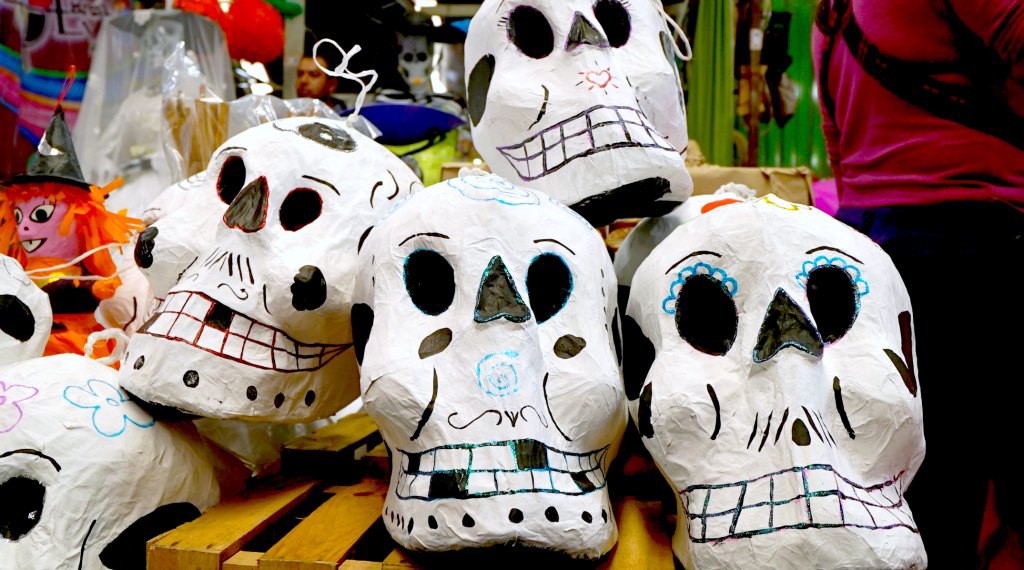
Colour Papier Mache Skulls
If you can find papier mache skulls that are ready to paint then draw decorating inspiration from this blog post at Kids World Citizen. If not, then this tutorial will take you through the (very lengthy!) process. Perfect if you’re looking to keep the kids busy for a few hours or more!
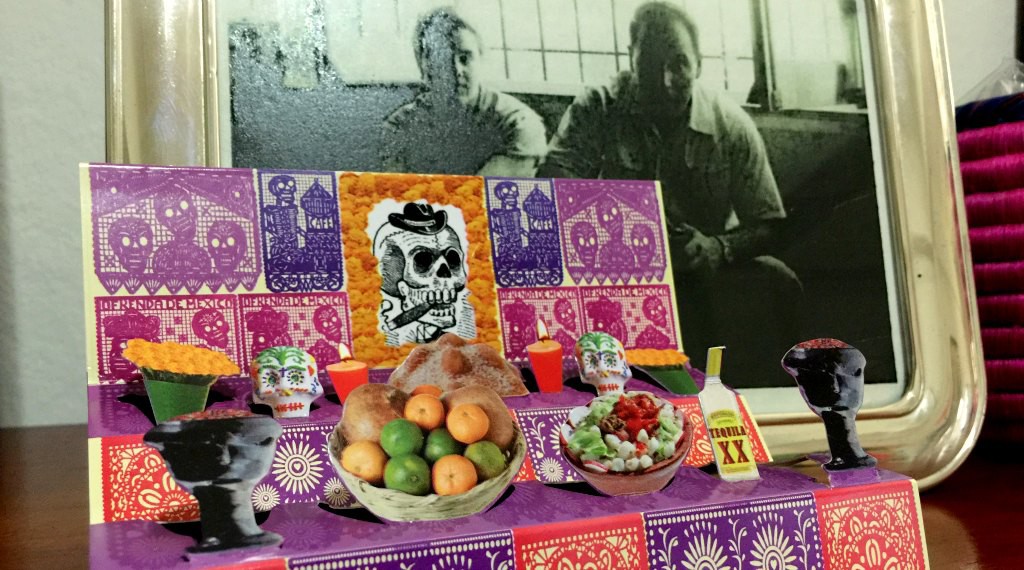
Build an Ofrenda
Ofrendas, or altars, play a principle part in Day of the Dead celebrations. Families will create an ofrenda in their homes in memory of their loved ones. Each ofrenda is different and personal but common elements include cempasuchils, photos of the deceased, brightly coloured papel picado (delicate paper cut outs) and favourite foods of their loved ones. Miniature ceramic figures of food or hobbies that the dead might have enjoyed are placed on the altar as well.
Places to experience Día de Muertos in Mexico
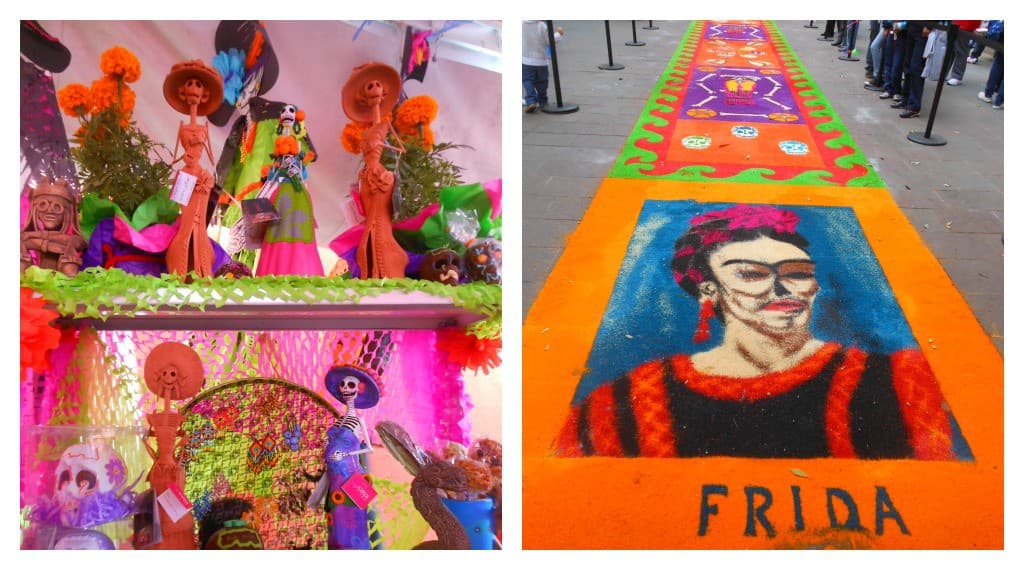
Every state and region celebrates the holiday differently but no matter where you travel in Mexico, you will find Day of the Dead celebrations. The following are just some of the more famous Day of the Dead destinations in Mexico. Note that some of these places get very busy so they may not be suitable for younger children.
Mexico City
Ever since James Bond witnessed hundreds of catrinas in El Zocalo in the opening scene of Spectre, the heart of Mexico City has enjoyed a cinematic parade for Día de Muertos.
Hundreds of participants take place every year, starting at the Angel of Independence and ending in the Centro Historico. Expect enormous puppet skeletons, mask-wearing dancers and elaborately decorated catrinas.
Other locations in the capital that are famous for their Day of the Dead celebrations include San Andrés Mixquic and Xochimilco.
San Andrés Mixquic, in the south of the city, has strong indigenous roots and every year graves are decorated with thousands of marigolds and hundreds of candles.
Xochimilco, again in the south, puts on a special night-time Day of the Dead excursions on a trajinera. Learn the spooky legend of La Llorona as you float along the waterways.
Pátzcuaro
The Island of Janitzio in Lake Pátzcuaro, in the state of Michoacan, is home to one of Mexico’s most famous Dia de los Muertos celebrations. The indigenous Purepecha people perform elaborate rituals in the local cemetery throughout the night. Pátzcuaro can be reached on a weekend trip from Mexico City.
Xico
One of Mexico’s pueblos magicos (magical towns), Xico, in the state of Veracruz, is famous for its colourful Day of the Dead celebrations, including an elaborate flower petal carpet along the road leading to the graveyard.
Oaxaca
Dia de los Muertos is one of the biggest celebrations of the year in Oaxaca. In addition to elaborate altars, tapetes de arena (sand tapestries) are common – detailed pictures made out of sand in honour of the person who has died.
Every year there is a giant tapete de arena outside the Museo del Palacio. One of the main cemeteries is the Panteon General (the Oaxaca General Cemetery), also known as the Panteon San Miguel.
Puerto Vallarta
Although not one of the most popular places to witness Dia de los Muertos, the beachside town of Puerto Vallarta is a fun place to witness the festivities with kids. Expect giant ofrendas, a colourful parade and gangly skeletons on stilts, towering above the crowds. If plan to stay at the beach then take a look at CasaGo, that have a great selection of houses and apartments that work well for families.

I’ve always loved the way Mexico celebrates and remembers the dead. Rather than filled with great sadness each year, you get a sense of remembrance of the life they lived.. not that you are living life without them. I can’t wait until trick or treating isn’t so huge for my son so that we can go to Mexico to celebrate Dia de los muertos there.
I couldn’t agree more! There’s something really moving about how the Mexicans approach death. I think the way that they actively remember their loved ones every year is such a lovely way to celebrate somebody’s life. I hope you can come here soon to witness Dia de Muertos in person!
This is awesome info, thank you for sharing! We’re in Tulum for it this year and I’m more excited having a better understanding. Looking forward to celebrating it here!
Thank you so much! I hope you enjoy the celebrations…and Tulum!
I would adore to visit Mexico some day with my kids. I’m in love with the culture, the clothes, the bright colours and sugar skulls! It’s great how they celebrate death in a good way. Hopefully one day I will take my family there. Sarah http://www.kippersandcurtains.com
Thank you! There is definitely something really moving about the way they celebrate death here. And yes, the colours are incredible in Mexico. One of the many reasons that I enjoy living here
It’s a really interesting festival that I would like to see one day. I have a lot to learn about the customs surrounding it, and I love Mexico so it’s a must for me.
I hope you get to experience it one day, it is one of my favourite festivals for sure.
I’ve only encountered Día de Muertos in London. Even here, I’ve found it quite moving. It’s just a very sensitive treatment of death
How interesting that you’ve seen it celebrated in London. I think it’s a really amazing festival and a really wonderful way to celebrate both life and death.
Looks like you had a great time celebrating. I love all of your colorful photos. You really brought the day to life!
Thank you!
Wow this looks so cool! I love the juxtaposition of how colourful this event is with the concept of it. I’m jealous of your kids as I never did such cool things when I was a child!
Thanks!! The kids definitely enjoy it, hopefully they’ll appreciate it in time 🙂
I lived in Mexico, but I was never there during the Dia de los muertos, which is why I’m even more curious about the celebration! I knew it was big in the past, but it’s nice to see that the people are still really celebrating it. It looks like a lot of fun, and I would love to eat one of those chocolate skulls right now… 🙂
Haha! Yes, they are quite delicious 🙂 Where did you live in Mexico? I hope that you get to come back and visit!
Dia de Muertos is a great day of celebrating, but I love how it can be joyous for the kids too. I’ve never thought about including younger ones but it’s nice to see it can be done.
Absolutely! It’s a great festival for them too and a wonderful way for them to learn about life and death.
I love this festival because it’s such an interesting view on death.It’s also such a colourful festival!
I agree! I think it’s a really healthy way to view death and I love the way they remember loved ones who have passed every year.
Wow! Día de Muertos has exploded in other countries over the past years. The colours are just magical.
The colours are definitely amazing. Have you seen it celebrated elsewhere in the world?
Great post and photos! We attended a Día de Muertos (Day of the Dead) celebration this year – so interesting.
Thanks! Where did you experience Dia de Muertos this year?
I love your photos of Dia de los Muertos! So colorful and intriguing. I’ve celebrated the holiday most of my life and enjoy seeing it expand to other areas.
Thank you so much! Do you celebrate it with your family?
I want to experience this first hand so very much!! Love all of your colorful photographs.
Thank you! It really is a fun festival and a lovely way to remember those who are no longer with us.
Hello, would you recommend Dia de los muertos festivities in Oaxaca with a 1 year old? we would not be partaking in any of the night celebrations, of course, but don’t know if even the day events are too hectic for an infant.
The evening events are definitely more lively but the nice thing about Oaxaca is that the old part of the city is not very big so you can always retreat to your hotel if you find things are getting too hectic. I hope that helps?